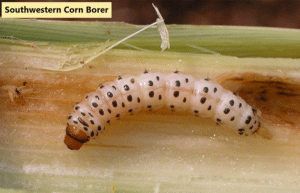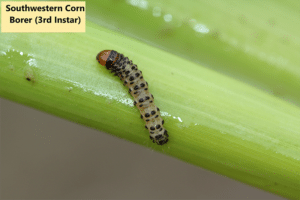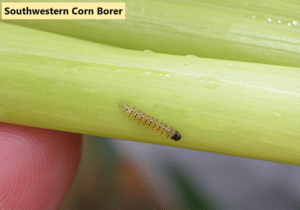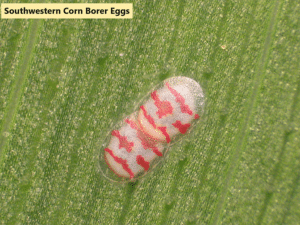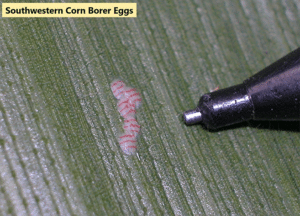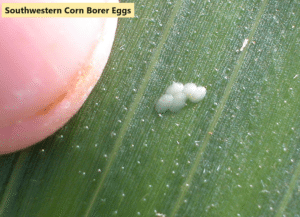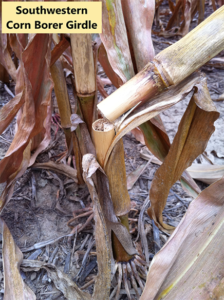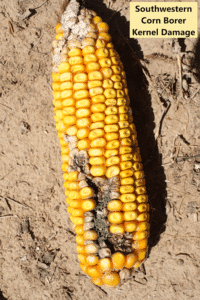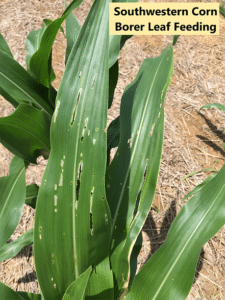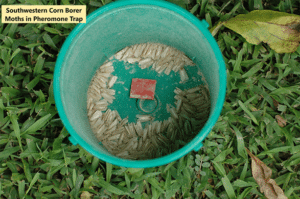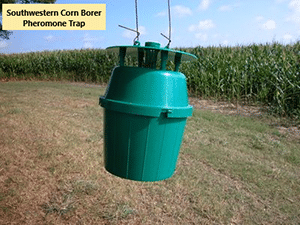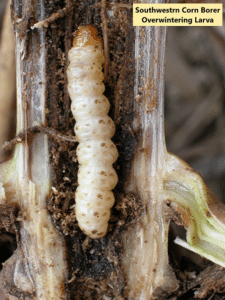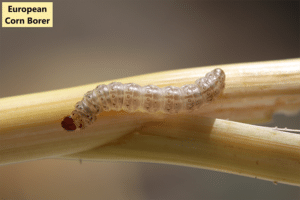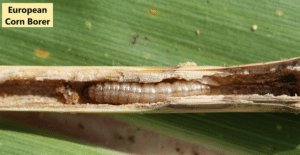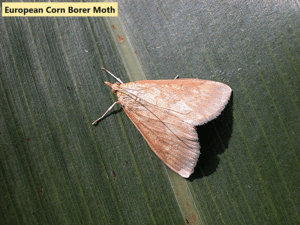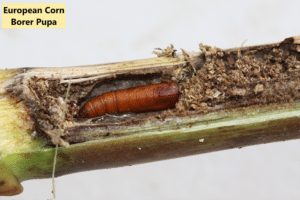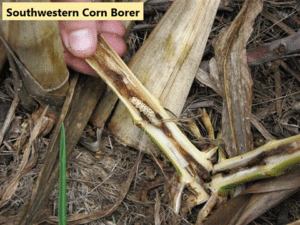 The southwestern corn borer (SWCB) is a well-known caterpillar pest of corn. Larvae are creamy white with large brown or black dots on each body segment and a dark head. Older larvae tunnel into the stalk, in ear shanks, or feed on ears until they pupate (usually inside the stalk). Tunneling interferes with nutrient and water flow within the plant and to the ears. Tunneled shanks may break, causing ears to fall on the ground. Overwintering larvae usually girdle the stalk from the inside. Girdling often results in lodging below the ear, particularly in high winds or when infested corn is not harvested in a timely manner. Lodging can dramatically reduce yield and slow harvesting operations.
The southwestern corn borer (SWCB) is a well-known caterpillar pest of corn. Larvae are creamy white with large brown or black dots on each body segment and a dark head. Older larvae tunnel into the stalk, in ear shanks, or feed on ears until they pupate (usually inside the stalk). Tunneling interferes with nutrient and water flow within the plant and to the ears. Tunneled shanks may break, causing ears to fall on the ground. Overwintering larvae usually girdle the stalk from the inside. Girdling often results in lodging below the ear, particularly in high winds or when infested corn is not harvested in a timely manner. Lodging can dramatically reduce yield and slow harvesting operations.
The European corn borer (ECB) is found throughout Tennessee and may be the most common corn borer species found in the Middle and Eastern parts of the state, although it is only an occasional pest of corn. ECB larvae are gray or tan with rows of light brown spots. The injury caused by ECB is similar to southwestern corn borer. During the whorl stage, feeding from ECB include elongated window-pane lesions on emerging leaves. In tasseling corn, small larvae are found behind leaf collar and sheath areas or in silks. Older larvae tunnel into the stalk, ear shanks, or ears until they pupate inside stalks or ears. Tunneling interferes with nutrient and water flow in the plant. Tunneled shanks may break, causing ears to fall on the ground. Injury to ears may affect kernel quality and introduce or spread disease organisms. Unlike SWCB, late-season tunneling tends to be concentrated in the stem near or above the ear, and ECB larvae do not girdle the stem prior to overwintering. One sign of ECB infestation is when stalks break above the ear compared to SWCB which often cause lodging below the ear.
Sampling: Scouting is not needed where Bt corn hybrids are used for corn borer control. For non-Bt corn, look on the undersides of leaves for corn borer egg masses. SWCB and ECB lay eggs in an overlapping pattern that look like small fish scales. SWCB egg masses are usually smaller (2-8 eggs) than those of ECB (10 or more eggs).
When corn is tasseling or silking, look for egg masses or small larvae feeding on the leaves. Corn borers lay their egg masses on the middle third of the plant near the ear zone, on the undersides of the leaves. Small larvae may be found between ear husks or behind leaf collars. It is important to correctly identify larvae which are found because corn borers, corn earworm and fall armyworm may all be present. Treatment for insect pests during this stage will be more difficult. Insecticidal control for corn borers in tasseling corn is generally not as efficient as corn in the whorl stage. Small larvae are more easily controlled than larger larvae.
Pheromone (sex-attractant) traps are also used to monitor various insect flights, and can complement an effective scouting program. Traps can be used in each county or on individual farms to provide producers with an advance warning of insect infestations. When several traps are run on a farm, the numbers of southwestern corn borer moths caught can be used to trigger a foliar insecticide application.
Southwestern corn borer. Prior to tasseling, treat for SWCB when 5 percent (or more) of plants are found with egg masses or live larvae or 7 to 10 days after pheromone traps catch an average of 50+ moths over a seven-day period. Beginning at tasseling (VT) and through the milk stage (R3), treat for SWCB when 10 percent (or more) of plants are found with egg masses or live larvae or 7 to 10 days after pheromone traps catch an average of 100+ moths on a seven-day catch. Treatment is generally not recommended once corn reaches the dough stage (R4).
European corn borer. For non-Bt corn, treat for ECB when 50 percent of the plants are infested or when one egg mass is found per plant. Use at least 20 gallons of water per acre for treating whorl-feeding insects. Direct the coarse spray down into the whorls for most effective control.
Management options
| Insecticide (Trade Names) for SOUTHWESTERN AND EUROPEAN CORN BORER | Lb Active Ingredient per Acre | Amount Formulation per Acre | Performance Rating |
| bifenthrin (Brigade 2E, Discipline 2E, Fanfare 2E) | 0.063 - 0.1 | 4 - 6.4 oz | 7 |
| chlorantraniliprole (Vantacor 5 SC) | 0.047 - 0.067 | 1.2 - 1.71 oz | 9 |
| chlorantraniliprole, bifenthrin (Elevest) | See label | 5.6 - 9.6 oz | 9 |
| chlorantraniliprole, λ-cyhalothrin (Besiege) | See label | 6 - 10 oz | 9 |
| esfenvalerate (Asana XL 0.66E) | 0.04 - 0.05 | 7.8 - 9.6 oz | 6 |
| methoxyfenozide (Intrepid 2F) | 0.0625 - 0.125 | 4 - 8 oz | 8 |
| permethrin (Pounce 3.2E) | 0.1 - 0.2 | 4 - 8 oz | 5 |
| spinetoram (Radiant SC 1) | 0.023 - 0.047 | 3 - 6 oz | 8? |
| spinosad (Blackhawk 36% WDG) | 0.05 - 0.07 | 2.2 - 3.3 oz | 6 |
| β-cyfluthrin (Baythroid XL 1) | 0.0125 - 0.02 | 1.6 - 2.8 oz | 6 |
| γ-cyhalothrin (Declare 1.25) | 0.01 - 0.015 | 1.02 - 1.54 oz | 6 |
| λ-cyhalothrin (Warrior II) | 0.02 - 0.03 | 1.28 - 1.92 oz | 6 |
| Z-cypermethrin (Mustang Maxx 0.8E) | 0.017 - 0.025 | 2.75 - 4 oz | 6 |
- Planting field corn early, during the recommended planting window, will reduce the chances of crop damage from several insect species.
- Bt technologies with corn borer protection provide a high level of control for SWCB and ECB.

